| There are 18 to 45 species of deciduous trees called elms. All are from the temperate northern hemisphere. They are fine foliaged trees valued for shade and handsome form; their wood is little used. Ulmus is the ancient Latin name. Elm flowers are tiny and give rise to thin, papery winged seeds that dry to recall wax paper; mostly they appear before the trees leaf out in spring, but 3 species flower and seed in autumn. Elm leaves are lopsided, veiny, sharply toothed, and short-stemmed. Fall color is normally an unremarkable yellow. |
| No elm grows larger or is more beautiful than the American white elm (U. americana). This species has all the inspiring, strong yet graceful presence of a grand cathedral. If you prefer a secular symbol, the Brooklyn Bridge will do. Nothing about the tree is crudely proportioned or objectionable. To behold its swooping branches and fine tracery of branchlets, symmetrically radiating upward, outward, and finally downward from the tall pillar-like trunk, can make us sigh with pleasure. Everything about the tree people love: strength, great size, pleasing shape, and elegance; a monumental beauty. |
| Pragmatists among us will cough, and beg leave to point out that elms are notorious "gross feeders" with rapacious root systems, are prone to breaking up in catastrophic chunks, and that the wafer-like seeds of spring can be an ankle-high nuisance. Nonetheless, when we judge by looks alone, American white elm, at least while still intact in its shapely grandeur, is an example of nature's best. François André Michaux (1770 - 1855), a keen, widely traveled naturalist, ended a lengthy account of this tree: "Such are the few and unimportant uses of the white elm in the United States; it is far inferior to the European elm which is a tree of very extensive utility, and it deserves attention in the Old World only as the most magnificent vegetable of the temperate zone." |
| Dutch Elm Disease (DED) is caused by the fungi Ceratocytis ulmi and C. novo-ulmi. It has killed millions of trees. It originated in Belgium, about 1900 to 1905, but received its name since it was first studied by Dutch scientists. In the early 1900s, seedling American elms were planted extensively in the United States, especially as street trees. Yet since the 1930s, DED has devastated our wild and planted elms, causing huge, costly and painful loss. So, since the 1980s and 1990s, emphasis has been placed on planting clonal hybrids or cultivars of disease-resistant elms. To find or breed one that ends up looking as grand as the best vase-shaped American white elms, is a worthy undertaking. |
In the 2nd edition of my book Trees of Seattle, I cite only two newer hybrid elm clones: Accolade™ and 'Pioneer'. In this article (updated in November 2009), I describe those plus five others: 'Frontier', 'Homestead', 'Patriot', Triumph™ and Ulmus Wilsoniana 'Prospector'. For each I cite examples, describe their origin, and show photographs.
|
| Ulmus Accolade™ |
| = Ulmus 'Morton' |
| (U. japonica x U. Wilsoniana) |
| Raised in 1924. Selected at the Morton Arboretum of Lisle, Illinois. Named in 1996. Introduced in the 1990s. A graceful vase-shaped crown. Vigorous. Resists DED, elm leaf miner, and elm leaf beetle. Leaves deep glossy green, relatively small, with about 13 to 15 pairs of veins. Good yellow fall color. |
In Seattle, 5 were planted in 2005 on the University of Washington campus south of Suzzallo Library; the tallest is 24 feet. In 2007, 6 street-trees were planted on Cherry Street, west of Broadway.
|
| Ulmus 'Frontier' |
| (U. minor x U. parvifolia) |
| Hybridized in 1971 by the USDA research station of Delaware, Ohio. It was released to nurseries in 1990. Tolerant of Elm Yellows and DED; moderate resistance to elm leaf beetle. The twigs are hairy --unlike most other clones. The leaves are small (average 2 and one-eighths inches long by 1 and one-fourth inches wide), and have 12 to 14 (15) pairs of veins. Unlike the other elms that turn yellow in fall, they turn a striking deep reddish-purple --like a purpleleaf plum tree. Also, some make little flowers in fall, as can be seen in my photo. The other elms bear their tiny flowers in spring. |
In Seattle, 6 were planted in the late 1990s at Green Lake near the boat rental building on the east shore. The tallest is 37 feet.
|
| Ulmus 'Homestead' |
| (U. pumila x [(U. hollandica 'Vegeta' x U. minor) x (U. pumila var. pinnato-ramosa x U. minor 'Hoersholmiensis')] |
| Hybridized in 1970 by the USDA research station of Delaware, Ohio. It was released to nurseries in 1983. Resists DED. The twigs are hairy --unlike most other clones. The leaves average 2 and three-forths inches long by 1 and two-thirds inches wide), and have 13 to 17 pairs of veins. They are quite hairy beneath. Unlike the other elms, it stays green very late into fall. |
In Seattle, 7 were planted in late 2008 south of 5 'Frontier' elms as street trees on the east side of Leary Way, south of NW Market Street, north of 20th Avenue NW.
|
| Ulmus x hollandica Mill. 'Pioneer' |
| (U. minor x U. glabra) |
| = Ulmus 'Pioneer' |
| Hybridized in 1971 by the USDA research station of Delaware, Ohio. Released in 1983. Common. The leaves average 4 and one-fifth inches long by 2 and one-fourth inches wide; with 16 to 19 pairs of veins. The crown is dense and notably broad. Fast and vigorous growth. Some resistance to DED, but leaf beetles attack it severely. |
In Seattle, 4 are planted on the University of Washington campus as street-trees south of Schmitz Hall on Campus Parkway. [A lone Siberian elm (U. pumila) is east of them.] They have plump buds and in spring make many seeds. They are wider than tall, the largest 25 feet tall, 28 feet wide.
|
| Ulmus 'Patriot' |
| (U. 'Urban' [(U. hollandica 'Vegeta' x U. minor) x U. pumila] x U. Wilsoniana 'Prospector') |
| Hybridized in 1980 by the U.S. National Arboretum. Selected and named in 1993. High DED and Elm Yellows resistance. Resists elm leaf beetle. Crown moderately vase-shaped. Leaves average 11 to 17 pairs of veins --highly variable likely because 4 species are involved in its genealogy. |
In Seattle, a street-tree is planted at 808 36th Avenue E.
|
| Ulmus Triumph™ |
| = Ulmus 'Morton Glossy' |
| (U. Accolade™ 'Morton' x U. Vanguard™ 'Morton Plainsman') |
| A controlled cross conducted by Dr. George Ware and selected at the Morton Arboretum of Lisle, Illinois. Named 'Charisma' in 1994; renamed 'Morton Glossy' in 1995. Introduced in the 1990s. It features notably glossy dark green foliage, a good upright form, strong, softly arching branching, and excellent disease resistance. Its foliage is liable to attack by elm leaf beetle and Japanese beetle. The leaves are about 4 inches long by 2 inches wide. |
In Seattle, 5 young street-trees are at 2720 3rd Avenue (near Cedar Street). My October 21st 2009 photo shows how someone crudely hacked off the tops of them. They have prominently cork-winged twigs.
|
| Ulmus Wilsoniana 'Prospector' |
| This species was discovered in west China by the great plantsman Ernest Henry Wilson (1876 - 1930) in 1900. It was introduced by him to the Arnold Arboretum in 1910, and was named in 1912. It was recorded up to 80 feet tall in the wild. The leaves are said to be rough above, downy beneath; the vein pairs numerous, 16 to 22. |
| However, the online Flora of China makes U. Wilsoniana Schneid. a synonymn of Ulmus davidiana var. japonica (Rehder) Nakai --of not only China, but also Japan, Korea, Mongolia, and Russia's Far East, and E Siberia. And the Flora of China makes U. Wilsoniana var. subhirsuta a synonymn of Ulmus Androssowii Litvinov var. subhirsuta (C. K. Schneider) P. H. Huang et al., 1991. |
| The cultivar 'Prospector' --regardless of its proper placement under a species-- originated as a seedling in 1963; was planted about 1965 in Delaware, Ohio; was selected in 1975 for evaluation; and was released in 1990. It tolerates elm leaf beetles, Elm Yellows and DED. Leaves average 4.5 inches long by 3.3 inches wide, are orange-red when young, and turn yellow early in fall. It is said to be much like Ulmus americana in form and texture, only not so large. |
In Seattle, 5 young street-trees are on Thomas Street, east of Westlake Avenue N. The tallest was 16 feet when I measured and photographed the nearly defoliated trees on October 21st 2009. The leaves I examined only had 14 - 15 vein pairs, were smooth above and had inconsequential hair tufts beneath, and to that extent do not fit the description of typical U. Wilsoniana.
|
| Certainly Seattle has other recently planted hybrids --or DED resistant east Asian species-- that I have not yet learned about. I welcome news of them, so I can amplify this article. The goal is to discover which ones end up proving to be the best for our landscapes. To be expected are: |
| Ulmus japonica 'Discovery' |
| Ulmus 'Morton Plainsman' Vanguard™ |
| Ulmus 'Regal' |
Please tell me of Seattle plantings of these. Thank-you to Bill Ames for some help already.
Back |
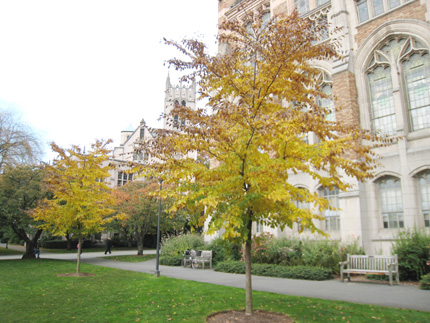
Accolade Elms by Suzzallo Library (photo by ALJ)
|
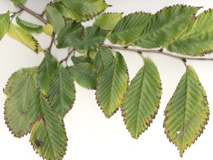
Accolade Elm twig & leaves (scan by ALJ)
|
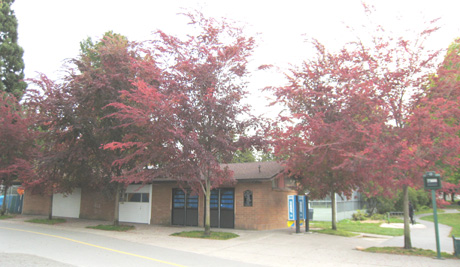
Frontier Elms at Green Lake (photo by ALJ)
|
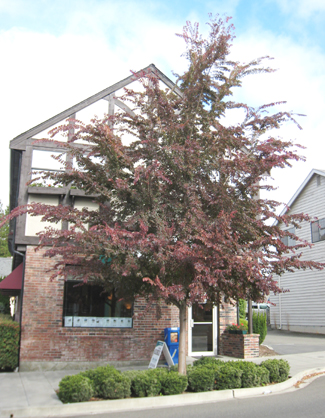
Frontier Elm in Burien (photo by ALJ)
|
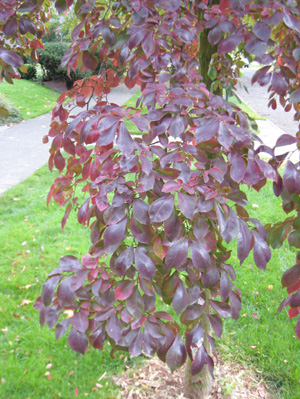
Frontier Elm 2136 E Shelby Street (photo by ALJ)
|
Frontier Elm twig, leaves & flowers (scan by ALJ)
|
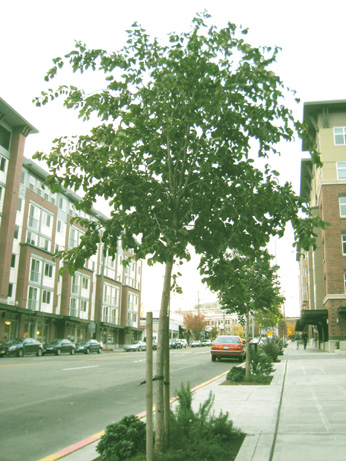
Homestead Elms on Leary Way (photo by ALJ)
|
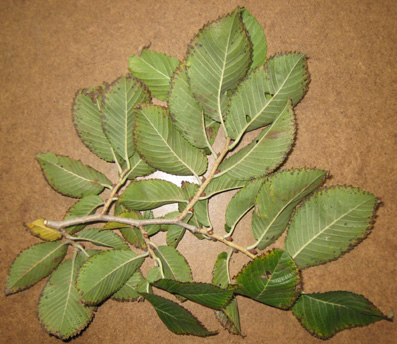
Homestead Elm twig & leaves (photo by ALJ)
|
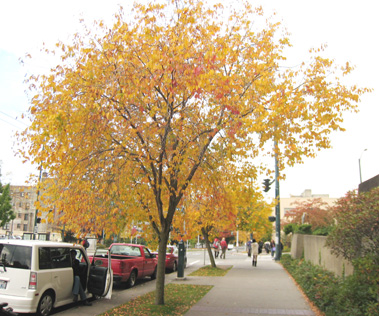
Pioneer Elms by Schmitz Hall (photo by ALJ)
|
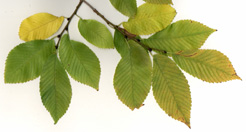
Pioneer Elm twig & leaves (scan by ALJ)
|
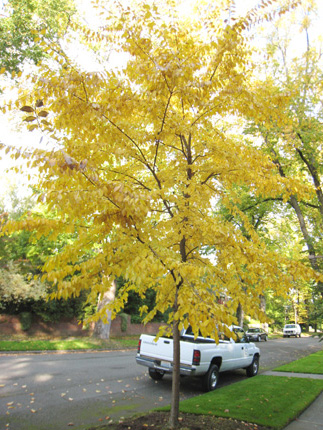
Patriot Elm on 808 36th Ave E (photo by ALJ)
|
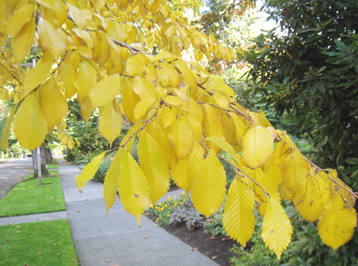
Patriot Elm twig & leaves (photo by ALJ)
|
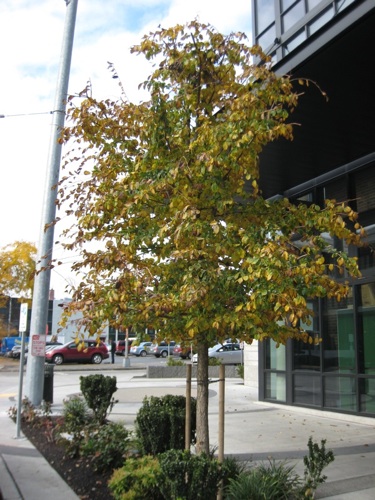
Triumph Elm on 3rd Avenue (photo by ALJ)
|
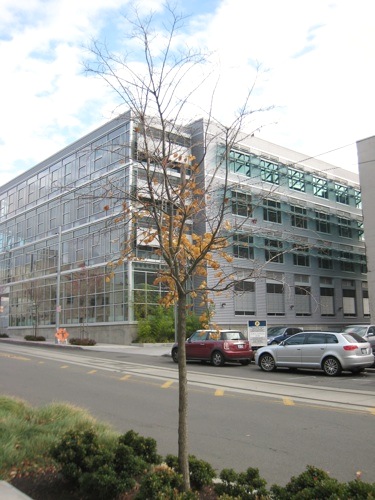
Prospector Elm on Thomas Street (photo by ALJ)
|

